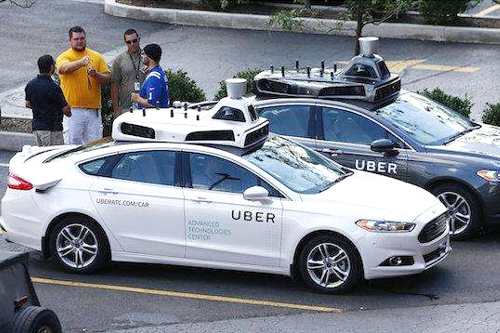Autonomous Cars: Pitt Stop
自动驾驶汽车:匹兹堡行车记
Uber launches its first self-driving cars
优步推出首批自动驾驶汽车
Sitting in the back seat of the self-driving Uber as it navigates narrow streets in Pittsburgh’s old industrial heart, the Strip District, is surreal. The global ride-sharing firm chose the area as the spot to develop and test driverless cars, and picked up its first customers on September 14th. Your correspondent got a ride the day before. The vehicle moves smoothly down busy Penn Avenue, stopping at four-way stop signs and traffic lights, slowing to allow other cars to parallel park. It navigates around double-parked delivery vans. It even stops to allow jaywalking pedestrians to cross.
坐在优步自动驾驶汽车的后座上,任其在匹兹堡老工业中心横排区(Strip District)狭窄的街道上行驶,感觉很不真实。这家全球拼车服务公司选择在这片区域研发和测试无人驾驶汽车,并在9月14日接待了第一批顾客。本刊记者在此前一天便体验了一次。所乘车辆沿交通繁忙的潘恩大道(Penn Avenue)平稳地行进,能依照四岔路口的停车标志及交通灯的指示停车,还会减速,以便让其他车辆侧方停车。这辆车能绕过并排停靠的厢式货车,甚至还会停下来避让乱穿马路的行人。
The cars are not truly driverless yet. During the trial an Uber employee sits behind the wheel, ready to take over should something go wrong. A second employee, a sort of co-pilot, sits in the front passenger seat, monitoring a screen, alerting the pilot to what the car “sees”, including other cars, upcoming traffic, potential obstacles and elevation – Pittsburgh is very hilly. Another monitor in the back seat allows passengers to see what the car is seeing.
这些车还不能算真正意义上的无人驾驶。试验过程中一名优步员工会坐在驾驶位,若发生问题会随时接管汽车。另一名算是副驾驶员的员工坐在前排副驾驶位上,通过一个屏幕监控车辆状况,并提醒驾驶员车辆“看到了”什么,例如其他车辆、前方交通情况、潜在障碍以及地面的高低起伏(匹兹堡多山)。后排座位也配有一个监视器,能让乘客了解车辆所看到的情况。
By the end of the year, 100 Volvos will be on the road, but in the meantime a fleet of Ford Fusions are picking up passengers. A large rotating laser (that strongly echoes the flux-capacitor from the film “Back to the Future”) is mounted on the roof. The car is also fitted with 20 external cameras, measurement devices for acceleration and orientation, 360-degree radar sensors and separate antennae for GPS positioning and wireless data.
到今年年底将有100辆沃尔沃上路,不过与此同时一个由福特混合动力蒙迪欧组成的车队已开始接送乘客。这些车的车顶安装了一台大型激光扫平仪(与电影《回到未来》中的通量电容器高度相似),此外还配有20个外部摄像头、加速及定向所需的测量装置、360°雷达传感器,以及用于GPS定位及无线数据传输的独立天线。

Pittsburgh is ideal for the tests. It has the talent, because Uber poached Carnegie Mellon University’s robotics department last year. Raffi Krikorian, who heads up the company’s research centre in Pittsburgh, calls the city the “double-black diamond of driving”. It has a winding road system, extreme weather conditions and lots of traffic. Drivers there are used to odd quirks like the “Pittsburgh left”, as it is known, where oncoming traffic yields to cars making left-hand turns. If Uber can master autonomous driving in Pittsburgh, Mr Krikorian says, it can make it almost anywhere.
匹兹堡是进行测试的理想之地。它拥有合适的人才,优步去年就砸重金从卡内基梅隆大学机器人中心“挖角”。该公司匹兹堡研究中心的负责人拉菲·克里科里安(Raffi Krikorian)称这座城市相当于“驾车领域的双黑钻级别”。这里有曲折的道路系统、极端的天气状况以及繁忙的交通。当地的司机们还习惯于不同寻常的转弯方式,例如人们熟知的“匹兹堡式左转”——在这种情况下迎面而来的车流会为向左转的车辆让路。克里科里安说,优步如果能在匹兹堡成功实现自动驾驶,便几乎能在任何地方推广该技术。
Having City Hall’s support for the urban lab helps. Even before Uber came to Pittsburgh, Bill Peduto, the mayor, was fighting state lawmakers to allow ride-sharing. Local government must take risks and behave like a startup, he says. “Regulation will never be ahead of innovation. If you sit and wait, the innovation will happen, but somewhere else.” The city is small enough that it can get things done, but large enough that the world should notice.
拥有市政府对实验室的支持也颇有裨益。早在优步来到匹兹堡之前,市长比尔·佩杜托(Bill Peduto)就一直在与州议员斗争,以使拼车获得准许。他说,地方政府应勇于冒险、像创业公司那样行事。“法规永远都不会领先于创新。如果你只是坐着干等,创新倒也会出现,但却会是在别的地方发生。”匹兹堡这座城市小到足以切实解决问题,但又足够大,能让世界注意到它的动向。
Put in the actual driver’s seat, for a short spell, your correspondent did need to intervene when midway through a turn, the traffic light turned red and the car suddenly stopped. But The Economist felt very safe. Not all Pittsburghers are convinced. “I’d want to know that it’s 100% foolproof before I’d get in,” says Shelby Rocco, a student. Mike Taylor, a banker, who uses Uber all the time, has no reservations. He feels bad for the drivers, who he suspects may lose their jobs, but “it’ll be nice not to have to keep up any more awkward conversations.”
本刊记者坐在驾驶座上,有那么一阵确实需要短暂地接管汽车——正在转弯时红灯亮起,车突然停住。《经济学人》觉得自动驾驶汽车还是很安全的,但这并不能说服所有的匹兹堡人。一位名叫谢尔比·洛科(Shelby Rocco)的学生说,“我得确定无人驾驶汽车百分之百没问题之后才会乘坐。”长期使用优步的银行职员麦克·泰勒(Mike Taylor)则对自动驾驶汽车毫无疑虑。他担心的是司机们也许会失业,因而为他们感到难过。不过“再也不用别别扭扭地与人交谈了,这点还是很好的。”
英文、中文版本下载:http://www.yingyushijie.com/shop/source/detail/id/488.html








